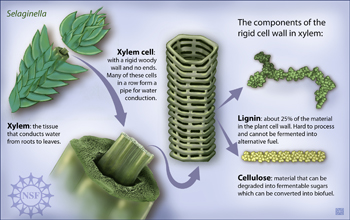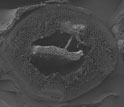News Release 08-084
When Plants "Think" Alike
New genetic evidence shows that the same trait developed independently on separate branches of the evolutionary tree

The primitive plant Selaginella has lignin and cellulose in many of its cell walls.
May 22, 2008
This material is available primarily for archival purposes. Telephone numbers or other contact information may be out of date; please see current contact information at media contacts.
Biologists have discovered that a fundamental building block in the cells of flowering plants evolved independently, yet almost identically, on a separate branch of the evolutionary tree--in an ancient plant group called lycophytes that originated at least 420 million years ago.
Researchers believe that flowering plants evolved from gymnosperms, the group that includes conifers, ginkgos and related plants. This group split from lycophytes hundreds of millions of years before flowering plants appeared.
The building block, called syringyl lignin, is a critical part of the plants' scaffolding and water-transport systems. It apparently emerged separately in the two plant groups, much like flight arose separately in both bats and birds.
Purdue University researcher Clint Chapple and graduate students Jing-Ke Weng and Jake Stout, along with post-doctoral research associate Xu Li, conducted the study with the support of the National Science Foundation, publishing their findings in the May 20, 2008, Proceedings of the National Academy of Sciences.
"We're excited about this work not only because it may provide another tool with which we can manipulate lignin deposition in plants used for biofuel production, but because it demonstrates that basic research on plants not used in agriculture can provide important fundamental findings that are of practical benefit," said Chapple.
The plant studied--Selaginella moellendorffii, an ornamental plant sold at nurseries as spike moss--came from Purdue colleague Jody Banks. While not a co-author on the paper, Banks helped kick-start the study of the Selaginella genome with NSF support in 2002, and is now scientific coordinator for the plant's genome-sequencing effort conducted by the Department of Energy Joint Genome Institute in Walnut Creek, Calif.
"Because Selaginella is a relict of an ancient vascular plant lineage, its genome sequence will provide the plant community with a resource unlike any other, as it will allow them to discover the genetic underpinnings of the evolutionary innovations that allowed plants to thrive on land, including lignin," said Banks.
Chapple and his colleagues conducted the recent study as part of a broader effort to understand the genetics behind lignin specifically, as the material is an impediment to some biofuel production methods because of its durability and tight integration into plant structures.
"Findings from studies such as this really have implications regarding the potential for designing plants to better make use of cellulose in cell walls," said Gerald Berkowitz, a program director for the Physiological and Structural Systems Cluster at the National Science Foundation and the program officer overseeing Chapple's grant. "Different forms of lignin are present in crop plant cell walls; engineering plants to express specifically syringyl lignin could allow for easier break down of cellulose. Overcoming this obstacle is an important next step for advancing second generation biofuel production."
-NSF-
-
Frond of the lycophyte Selaginella moellendorffii.
Credit and Larger Version -
Lead author Jing-Ke Weng of Purdue University.
Credit and Larger Version -
Scanning electron microscope view of the water conducting tissues of lycophyte Selaginella.
Credit and Larger Version -
Scanning electron microscope view of the stem anatomy of the lycophyte Selaginella.
Credit and Larger Version
Media Contacts
Joshua A. Chamot, NSF, (703) 292-7730, email: jchamot@nsf.gov
Susan Steeves, Purdue University, (765) 496-7481, email: ssteeves@purdue.edu
Program Contacts
Gerald Berkowitz, NSF, (703) 292-7879, email: gberkowi@nsf.gov
Principal Investigators
Clint Chapple, Purdue University, (765) 494-0494, email: chapple@purdue.edu
Co-Investigators
Jing-Ke Weng, Purdue University, (765) 494-0657, email: wengj@purdue.edu
The U.S. National Science Foundation propels the nation forward by advancing fundamental research in all fields of science and engineering. NSF supports research and people by providing facilities, instruments and funding to support their ingenuity and sustain the U.S. as a global leader in research and innovation. With a fiscal year 2023 budget of $9.5 billion, NSF funds reach all 50 states through grants to nearly 2,000 colleges, universities and institutions. Each year, NSF receives more than 40,000 competitive proposals and makes about 11,000 new awards. Those awards include support for cooperative research with industry, Arctic and Antarctic research and operations, and U.S. participation in international scientific efforts.
Connect with us online
NSF website: nsf.gov
NSF News: nsf.gov/news
For News Media: nsf.gov/news/newsroom
Statistics: nsf.gov/statistics/
Awards database: nsf.gov/awardsearch/
Follow us on social
Twitter: twitter.com/NSF
Facebook: facebook.com/US.NSF
Instagram: instagram.com/nsfgov






